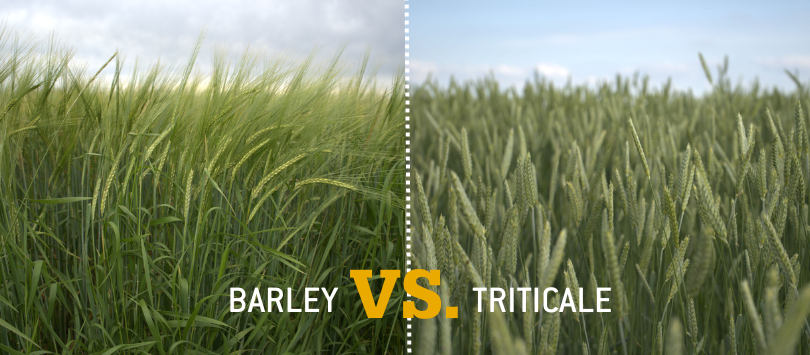Explore the differences between barley and triticale as forage options in Western Canada and discover the best choice for your farm.
Exploring the Benefits of Barley as a Forage Crop
Barley is a versatile forage crop that offers a range of benefits for farmers in Western Canada. One of the main advantages of barley is its high yield potential and ability to produce large quantities of biomass, making it an excellent choice for livestock feed. Additionally, barley is relatively easy to grow and requires minimal inputs, making it a cost-effective option for farmers.
Another benefit of barley as a forage crop is its nutritional value. It contains a good balance of protein, energy, and fibre, making it suitable for most livestock species. Barley forage is particularly beneficial for dairy cows, as it can help improve milk production. It also provides essential nutrients for beef cattle, sheep, and horses.
Barley's adaptability to Western Canada's diverse climate and soil conditions is a key advantage compared to other forage crops. It can withstand a wide range of temperatures, from cool spring to hot summers, and is known for its resilience in drought and other environmental stresses. These qualities make it a reliable choice for farmers in the region, ensuring a stable forage supply even in challenging conditions.
Understanding the Advantages of Triticale for Forage Production
Triticale is another popular forage option for farmers in Western Canada. It is a hybrid crop derived from a cross between wheat and rye. Triticale offers several advantages for forage production, making it a viable alternative to barley.
One of the main advantages of triticale is its high yield potential. It can produce a significant amount of biomass, providing ample feed for livestock. Triticale also has a high protein content, which is beneficial for animal growth and development. It is particularly suitable for dairy cows, as it can enhance milk production and improve milk quality.
Triticale is also known for its ability to adapt to different soil and climate conditions, including marginal soils. It can tolerate colder temperatures and is resistant to diseases and pests, making it a resilient crop for Western Canada. Additionally, triticale has a deep root system, which helps improve soil structure and reduce erosion.
Another advantage of triticale is its versatility as a forage crop. It can be used for grazing, hay production, or silage, providing flexibility for farmers. Triticale can also be grown in rotation with other crops, helping to improve soil health and nutrient cycling.
Comparing the Nutritional Value of Barley and Triticale for Livestock
Regarding the nutritional value of barley and triticale for livestock, both crops offer a range of essential nutrients. However, there are some differences to consider.
Barley's high energy content makes it an excellent choice for livestock that require a lot of energy, such as beef cattle. It also contains a good amount of protein, although the protein quality is slightly lower compared to triticale. The high fibre content in barley forage aids in digestion and promotes gut health in animals, further enhancing its nutritional value.
Triticale has a higher protein content than barley. This makes it a suitable option for livestock that require more protein in their diet, such as dairy cows. Triticale also contains a good amount of energy and fibre, providing a balanced diet for animals.
Ultimately, the choice between barley and triticale will depend on several factors, including farm location, as barley is a much shorter-season crop than triticale, even for forage purposes, but also the specific nutritional requirements of your livestock and the goals of your farm. It may be beneficial to consult with your local agronomist to determine the best option for your operation.
Climate Considerations for Growing Barley and Triticale in Western Canada
Both barley and triticale are well-suited to the climate conditions in Western Canada, offering you a secure and confident choice. However, there are some factors to consider when choosing between the two crops.
Barley is known for its short-season and early maturing crop and adaptability to different climates and soil conditions. It can tolerate a wide range of temperatures, from cool spring conditions to hot summers. Barley is also relatively drought-tolerant, making it a resilient crop for regions that experience dry spells.
Triticale, being a hybrid of wheat and rye, inherits some of the traits from its parent crops, including being a full-season crop. It is well-suited to cooler climates and can tolerate colder temperatures compared to barley. Triticale is also resistant to diseases and pests, making it a reliable option for farmers in Western Canada.
Ultimately, the choice between barley and triticale will depend on your region's specific climate conditions and the length of the growing season. When selecting a forage crop, it is important to consider the average temperatures, frost dates, and precipitation patterns in your area.
Making an Informed Decision: Which Forage Option is Right for Your Farm?
Choosing the best forage option for your farm in Western Canada requires careful consideration of various factors.
First, assess the specific needs and nutritional requirements of your livestock. Determine the energy, protein, and fiber requirements of your animals to select a forage crop that can meet their dietary needs.
Next, consider the climate conditions and soil characteristics of your farm. Evaluate the average temperatures, frost dates, and precipitation patterns to choose a crop that is well-suited to your region.
Additionally, think about your farming goals and priorities. Can you grow a full-season crop, or do you need a short-season one? Are you looking for a high-yielding crop, or do you prioritize nutrient value? Do you plan to use the forage for grazing, hay production, or silage? Consider these factors to make an informed decision.
CANTERRA SEEDS offers top-quality feed barley and triticale, including AB Wrangler 2-row feed barley and TriCal™ Surge spring triticale. And our pipeline is full of new forage varieties coming soon, including AAC Lariat 2-row feed barley, AB Maximizer 2-row feed barley, and AB Snowcat winter triticale. Talk to one of our Pedigreed Seed Territory Managers about your options, or reach out to a local seed grower near you.
In conclusion, both barley and triticale are viable forage options in Western Canada, each with its own advantages. Your role as a farmer in considering the benefits, nutritional value, climate considerations, and your specific farm requirements is crucial. By making an informed decision, you can choose the best forage option for your operation, contributing significantly to the success of your farm.


